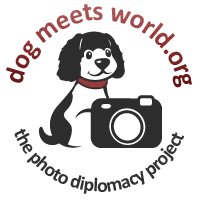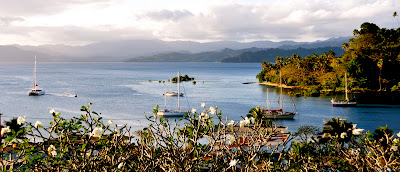Which is the better way to go? Is it "slow travel," where you stay in one place for a long time and soak in a microcosm? Or is tourist travel better, where you cover lots of ground and do lots of exploring? This is an important consideration as you plan your next trip. After all, you only have so much time, money, and stamina, and you really want to get the best out of your short time away. Based on our experiences this past year, it seems to me that the answer is, “It depends.”
We left the US in September 2009 and traveled through July 2010, visiting the Fiji Islands, Australia, Thailand, Singapore and New Zealand. Calling it, “The Year of Homeschool in a Global Classroom,” we focused for the most part on homeschooling our then fourth and sixth graders. We engaged in both slow and tourist travel, with varying results.
While in Fiji, we rarely strayed more than 20 kilometers away from our rental home at SigaSiga. The pace of life was much slower -- we literally planned our days around the tides. With no car, we hoofed, bussed or cabbed it everywhere. With nothing to buy, there was no reason to go into town unless we really needed food. We explored our surroundings at a much slower and deliberate pace, returning to spots numerous times. We established weekly rituals, like joining the local Rotarians for dinner each Tuesday. In the course of all this, we made many more lasting friendships, learned a lot about the peoples we were living around and, in our own tiny way, were actually a part of Savusavu goings on for a time. We were “home” on the other side of the globe.
 |
| So many reefs, little time |
The cost of living this “slow travel” existence was that we only managed to really explore one small part of one of Fiji’s 300 islands. (Not that I'm complaining about it!) We became experts on our local reef at the cost of missing thousands of kilometers of other spots. We got to know our First Fijian and Indo-Fijian neighbors to a certain point but left, we felt, as we were just on the cusp of taking our friendships to a new level, with all the good and bad that that entailed.
In short, we left Fiji having only scratched the surface. If Savusavu were just a short hop away from the States, or if there weren’t so many other island chains to explore in the South Pacific, this wouldn’t be all that troubling. It remains the sentimental favorite part of our trip, but a place we may be reluctant to return to for lack of time and financial reasons.
Our travel experiences beyond Fiji by contrast were more broad-stroke. The longest time we stopped anywhere was at most two weeks or so -- okay, we did stay for a month and then some in Bangkok. We gained a good broad view of what each country and its peoples were like. We learned more or less how to get around, where the great tourist and cultural spots are and how to quickly get settled in and comfortable in budget accommodations for four. We experienced first hand some of the downsides of all this “tourist travel” as well though.
The biggest drawback of being touristy, of course, was the expense of it all. With only temporary digs, we couldn’t stock up on groceries, take advantage of long term lodging discounts, or pick up the little time- and money-saving tricks native to every geography. (E.g., Where is the best place to buy specific items? When is the best to time visit certain sites? Etc.)
It could also be a very difficult and sometimes a lonely existence constantly traveling from place to place, living out of a few suitcases and having to get our bearings over and over again. City and place names had a tendency to melt into each other. And we just couldn’t really meet any locals, requiring a level of “family togetherness” that is sometimes hard to sustain.
We had none of these problems in Fiji – well, okay except for the family togetherness struggles at times. Life had developed a kind of normalcy there that we came to miss, something we weren’t really able to duplicate for the remainder of the trip.
For the above reasons, one might think that slow travel has the edge over fast, but consider the variety of places we visited. Savusavu, Fiji was tiny and, because of the bad roads and our lack of transportation, we had to travel slowly. The population was likewise small and incredibly welcoming. We couldn't help but feel at home, almost from the get go. To some extent, we chose Savusavu as our first destination because we knew that we wanted to live on "Fiji Time." "Fiji Time" does not exist everywhere though.
Bangkok was perhaps the polar opposite of Fiji for us. How long would it take to feel like you are a part of a community with ten million people speaking a different language, with a vastly different set of cultural rules and traditions and undergoing a major political upheaval? No, we didn’t stay there as long but by moving around a lot, we did manage to learn a lot about Thailand and its peoples. We even got a little snippet of understanding of the significant political challenges that are facing the country as the Red Shirts and government battle it out over who is really in charge.
Then there are places like New Zealand, which are so large and rich in terms of natural wonders that it would be a shame to spend a huge chunk of time in any one region. We all agree that we would have been bored silly had we stayed in Christchurch for six or eight weeks as we had originally intended. You just need to get out and about to experience the beauty of that place.
The Many Faces of New Zealand
So, it seems to me that the places we visited last year called for different travel strategies. We couldn't do it all and we couldn't "do" each country the same way. With lots of help, lots of luck and a strong willingness to be flexible, we managed to put together a really great year.
There are ways to combat the isolation and lack of in-depth knowledge of a place that comes with traveling fast. Here are a few that worked for our family:
Do your homework! While a good guidebook is invaluable, go beyond that. Seek out and read books by local authors detailing the history and culture of the places you are visiting. In New Zealand, for instance, we found a great series of historical fiction books, which described specific places and events in Kiwi history from a child’s point of view.
Watch movies, search the blogosphere and soak up as much as you can about the place before you go. All this “research” will give you context that you won’t have time to gain on a short visit alone. You’ll be more in tune with what look for, and you may just spot things that only a local would appreciate.
Plug in….but not too much. We watched the TV news every night and read the local newspaper, giving us a great idea of local goings on. This worked less well in Thailand, where we didn’t speak the language, but you can still garner a lot about a culture by looking at advertisements and seeing what sort of entertainment the locals enjoy.
One spot where this practice worked spectacularly well for us was Wellington, NZ, where we were able to use the nightly news to learn about the workings of the Kiwi Parliament before and after visiting the famous “Beehive" where they do the Peoples' business.
 |
| Hoof it. |
Put on your walking shoes. Plan on walking…alot. Get a good map and explore your surroundings, rather than watch them go at many miles per hour.
Where you can, climb out of the rental car or taxi and use public transportation to get around. We also found that, with the notable exception of Sydney, public transportation employees were very helpful in pointing us in the right direction.
By traveling with the masses, you might see less geography but you’ll enjoy a lot more of the benefits of slow travel. Buses don’t always take the most direct route so you can find new spots to explore that you might not have read about. Out of the cocoon of a car, you also have a much better chance of interacting with locals and getting their take on life. And or course, you’ll be reducing your carbon footprint!
 |
| Bus it! |
Follow your interests. We are avid birders and fish-watchers, so we sought out nature-watching opportunities in every destination. This became a running theme of our trip and a way to compare and contrast the variety of environments we visited, as well as the political, economic, and cultural factors that affected wildlife populations.
You don’t have to be a bird-brain to gain such insights on your own trip though. Pick something that interests you -- art, food, architecture, fishing, religious traditions, whatever – and delve into it at your destination. Such a focus will provide a framework for your itinerary and a great way to appreciate the similarities and differences between countries and cultures on a subject matter with which you are already familiar.
Keep your ears open!
Keep a “slow travel” mindset. Perhaps most important of all, slow down! That is perhaps the biggest and most valuable souvenir of our year studying abroad. Wherever you go, don’t try to do it all. Use your pre-departure planning (or a well-run tour service) to put together an itinerary that is lean but open to changes on the fly. Keep your eyes and ears open and mind amenable to drinking it all in, even if “it” occurs in a space that is smaller than a city block.
Happy trails.
-- Brooke Drury, Staff







































